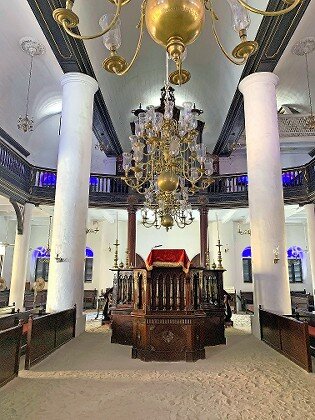Bat mitzvah shifts destination: Israel to Curaçao
When Hamas terrorists struck on Oct. 7, hundreds of b’nai mitzvah celebrations in Israel were put on hold or canceled.
Gabriella (“Gabi”) Kittrie had been studying with her religious-school instructor and preparing a d’var Torah for her assigned parshah, Vayechi.
Four years earlier, her older brother Ari had celebrated his milestone event at the Kotel with their parents, Orde and Elizabeth Kittrie, and several Israeli family members and friends. They were planning a similarly meaningful and spiritually uplifting celebration at the Kotel for their daughter.
But when British Airways canceled their tickets to Israel in early November, they sprang into action, looking for a Jewishly meaningful place that could accommodate them on short notice.
That’s when they thought of the oldest synagogue in the Western Hemisphere, on Curaçao in the Caribbean.
Congregation Mikvé Israel-Emanuel is nestled in the bustling port city of Willemstad, a formerly walled city and a favorite stop for cruise ships and more than a half million tourists each year.
One of the features of the island is the vibrant palette of colors that mark its historic architecture. The bright canary yellow and tan building that houses Mikvé Israel-Emanuel traces its history to 1730. Several of its present members can track their family roots back more than a dozen generations.
One of those is Mali de Waard, the synagogue’s president, who claims family roots on Curaçao to the 16th century and a family heritage that can be traced even further back to Amsterdam, where her ancestors had fled the Inquisition on the Iberian Peninsula.
Locals like de Waard refer to Mikvé Israel-Emanuel as the “Snoa,” a sobriquet for “synagogue” in Papiamento, a Creole language influenced by African dialects and based on an amalgam of Portuguese, Spanish and a little Dutch. Etymologists suggest it is probably derived from the Portuguese word esnoga for “synagogue.”
Founded originally in 1651 as an Orthodox synagogue with Sephardic traditions by Dutch and Brazilian Jews, the first Torah scroll was donated by the Amsterdam Jewish community in 1659. A building for the community was purchased in 1674, and the present building was erected in 1730 with major renovations occurring in 1878 and 1974.
With its high vaulted ceiling, massive chandeliers, dark mahogany pews, interior pulpit and imposing holy ark that holds more than a dozen sefer Torahs, the Snoa has been often favorably compared to the Great Synagogue in Amsterdam.
Another central feature of the synagogue is the application of white sand on its floor, which is often raked to remove footprints. According to legend, conversos — converts to Christianity who still secretly practiced Judaism — used sand to muffle the sounds of footsteps and to deaden the volume of the prayers lest they be overheard by eavesdroppers. The congregation placed sand on the floor at the time of its founding and today is one of only four in the world — all located in the Caribbean — to continue the practice. The others are in Suriname, St. Thomas and Jamaica.
Congregants at Mikvé Israel-Emanuel additionally refer to the sand as an ever-present reminder of the 40 years of wandering by the Hebrews in the desert.
As the Kittrie family learned, the history of the synagogue and the story of the Jewish people in Curaçao requires more than the collective memory of its congregants. A small museum filled with artifacts is housed in an enclave of the building opposite the courtyard that leads to the sanctuary doors.
Museum tours (daily except on Shabbat and Jewish holidays) inform visitors of a schism in the middle 19th century when elements within Mikvé Israel broke away and formed their own Reform Jewish congregation, Emanu El. For more than 100 years, the two groups maintained separate synagogue buildings but due to dwindling attendance, the two reconnected, merging into the renamed Mikvé Israel Emanuel in 1964.
Today, the synagogue is part of the Reconstructionist movement associated with the Portuguese Dutch community and is fully egalitarian.
An imposing pipe organ built in Amsterdam in 1865 is housed on the sanctuary’s second floor. Occasionally still played at services, it is the oldest in the region and the second oldest in the Americas.
The combined the bat mitzvah with a week of sightseeing on Curaçao for everyone to familiarize themselves with the important Jewish history of the island.
“Since my family is Mexican Jewish, I was particularly intrigued by the heavy Hispanic influences on the culture of Curaçao and particularly its Jewish community,” said Orde Kittrie. “I enjoyed learning how the Curaçao Jewish community was at one time the largest in the entire Western Hemisphere, and how it went on to inspire and help build the beginnings of the US Jewish community.”
The synagogue can be visited during the week, and is open for Shabbat services on Friday nights at 6:30 pm and Saturday mornings at 10 am as well as for all Jewish holidays. Prohibitions are enforced at the door on immodest clothing that might expose shoulders, and for torn or faded jeans and open-toed footwear, especially flip-flops. Head coverings are required for men and suggested for women.
Initially, when she learned of the trip to Israel being canceled, she was heartbroken, said Gabriella. “I was upset because I couldn’t get to Israel, and we had relatives and friends there, but I was definitely happy” when the family decided on Curaçao “because it wouldn’t be the same as my brothers’ [milestones].”
In addition to the balmy weather and the unique aspects of the celebration, Gabriella emphasized her delight in being in Curaçao. “It’s very historical, and it seemed like it had a great Jewish community,” she added.
“Also, for me, I’m really into beaches, and I’ve always wanted to go the Caribbean,” Gabriella noted. “And what’s better than getting a tan?”
In addition to Congregation Mikvé Israel-Emanuel, which is located downtown and near many hotels and beaches, Curaçao also has an Orthodox congregation further inland, Shaarei Tsedek Congregation.






